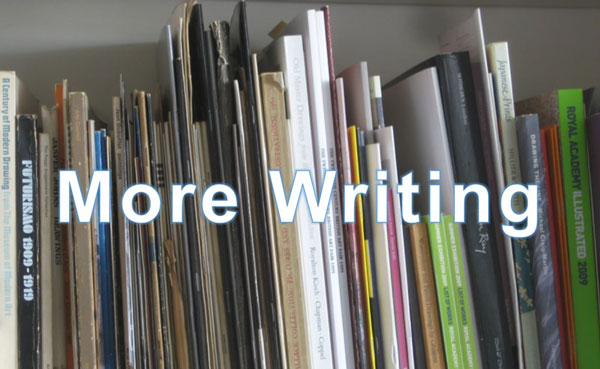David Royle
REVIEWS & INTERVIEWS
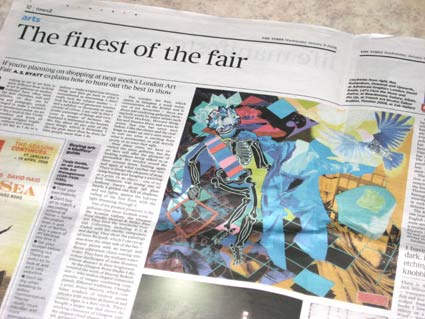
The London Art Fair, January 2008
Beardsmore Gallery, stand 23
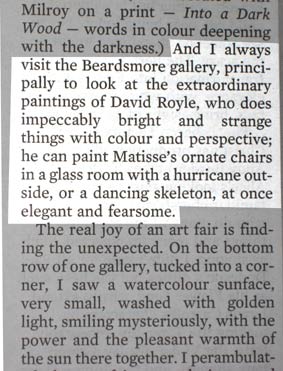
Cutting from "The Finest of the Fair"
by A.S. Byatt, The Times, Wednesday 9th January 2008
by A.S. Byatt, The Times, Wednesday 9th January 2008
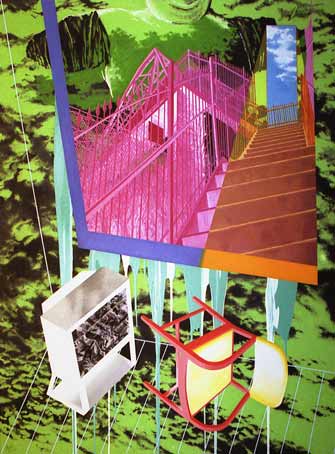
From.."The best-kept arts secrets in Britain"
The Observer, Sunday 17th September 2006
A.S. Byatt, Novelist, on David Royle, Painter.
David Royle has been painting for more than 30 years
now, brilliant and subtle paintings which explore space
and colour in new ways (left). He is one of a generation
of excellent painters whose work has been less available
than they deserve, owing to fashions for installations,
videos and so on. At the moment he is painting domestic
things transfigured in a kind of cosmic space looming
and spreading outside fragile walls. He is brilliant with
the garish colours of urban worlds. He is delicate with
surfaces of water and hidden depths.
left: "Jacob's Ladder I"
oil on linen, 72 x 54ins, 183 x 137.2cm
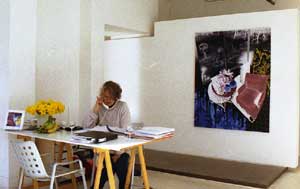
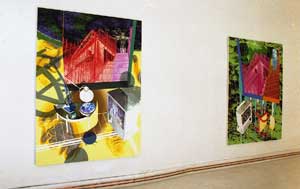
From the Ham & High, London, 19th March 2004, Alison Oldham reviewing the exhibition at the Beardsmore Gallery
David Royle’s engagement with art is as much about ideas as it is about painting…I related most to the recent paintings based on the area of west London where he lives. In these, a jumble of elements conveys desolation - upturned chairs, blank-screened televisions with static, and local scenes, including the bridge over the old Great Western railway called Jacob ’s Ladder. The snatches of cityscape resemble a film negative, and he deploys synthetic, eerie colours - magenta, orange and the green seen through night-vision lenses. Familiarity and fascination with his surroundings make his urban paintings stronger than the Villa Maria series based on an earlier stay in southern France. But the colours of these reflect heat and bright light, and they have a bittersweet charm.
These are cinematic paintings that juxtapose images of Royle’s life and ideas in a personal way that speaks of the modern world to many people.
David Royle’s engagement with art is as much about ideas as it is about painting…I related most to the recent paintings based on the area of west London where he lives. In these, a jumble of elements conveys desolation - upturned chairs, blank-screened televisions with static, and local scenes, including the bridge over the old Great Western railway called Jacob ’s Ladder. The snatches of cityscape resemble a film negative, and he deploys synthetic, eerie colours - magenta, orange and the green seen through night-vision lenses. Familiarity and fascination with his surroundings make his urban paintings stronger than the Villa Maria series based on an earlier stay in southern France. But the colours of these reflect heat and bright light, and they have a bittersweet charm.
These are cinematic paintings that juxtapose images of Royle’s life and ideas in a personal way that speaks of the modern world to many people.
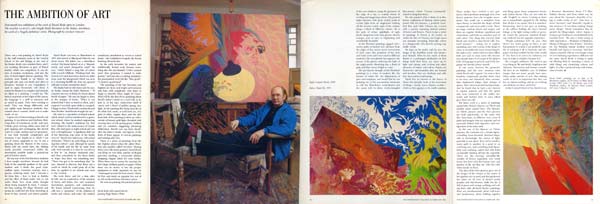
From The Ambition of Art, a profile in the Independent Saturday Magazine 22Feb.1992 by A.S.Byatt
There was a red painting by David Royle in the staff common room at the Central School of Art and Design at the end
of the Sixties. Royle was a student there, and I was teaching literature as part of liberal studies, which was
compulsory… He was one of the best literature students I have taught anywhere, because he had both of the
essential qualities of the good student, and, I think, the good artist: endless, open, voracious curiosity, and a precise,
ordering mind. And I learned a lot from him - how to look at Rothko and the effect of black under red, or red under
black, how visual artists thought about being haunted by form.
The idea of the Oasis pictures grew out of the images of the woman at the centre of her garden cave or pool (in the
Déjeuner sur l’Herbe paintings), and the patchwork has taken on all sorts of slicked earthy purples and clay-browns,
while the sky is full of green and orange writhing and coiling lines. Like all David Royle’s paintings, these are
simultaneously about coherence and incoherence, about holding together and flying apart, about sumptuous beauty
and violent threat. They are not what he calls "English" in colour. Looking at them one is immediately gripped by the
feeling that this is too much, that it is somehow threatening. And if one goes on looking, at the yellows holding the
heavy burned foliage, at the light resting ruddy or greenish round the generous minimal female, one suddenly has
the opposite experience.
"People sometimes feel". He says, "that there’s too much going on there, it isn’t harmonious or restful. I am perfectly
capable of reducing it all to harmony and elegance, but that wouldn’t be the truth, would it? You have to try not to be
reductive, you have to make it complex, because it is."
He is hugely ambitious. He wants to get everything in, life and death, brightness and darkness, destruction and
human warmth… What makes anyone so sure that making works of art is so important that they can live on almost
nothing, and go on working out relations of colour and form?
At the Central School of Art, David wrote a literature dissertation about T.S. Eliot, Wallace Stevens and Yeats which
was, he says, about the "necessary absurdity of trying to make works of art". (You have to stress "necessary" and
"absurdity" equally in that sentence.) David remembers that he quoted the Bhagavadgita, where Arjuna is trying to
get Krishna to reveal himself in his essential form: "He uses a whole string of superlatives - Elephant of Elephants,
Mango of Mangoes, Sun of Suns." And then for one blinding instant Krishna reveals himself, and Arjuna is overcome.
And then Arjuna responds with an even longer string of superlatives, different but the same. David Royle is trying to
paint the blinding flash by amassing a variety of solid things and connecting colours and lights. It is like primeval soup
with intimations of order.
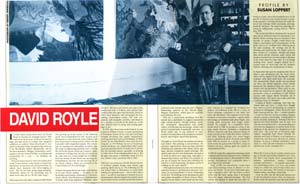
From David Royle, a profile in "Art Line" magazine, spring 1992 by Susan Loppert
Throughout David Royle has painted and drawn and etched. The painting is extraordinary, obsessional,
expressionistic; there are huge canvasses pulsating with violent colour and large luscious voluptuous pastel drawings…
Although not planned in series, his work seems somehow always to develop into obsessive variations on recurrent
themes. A series of paintings in the late 70’s dwelling on the simultaneous gore and golden tranquillity of illness
(Cancer Ward, inspired by his father’s slow death) and his baby son’s sojourn in hospital for treatment for asthma,
was followed in the 80’s by a series of twelve paintings, completed in just under two years, the Wasteland. This
sequence revels in the interplay of luxuriant naturalistic vegetal motifs with images of urban blight: wire fencing grids
contrasted with jungly undergrowth, for example. In a compulsive three month burst in 1988, he produced a series of
ten large pastel Interiors (including a magnificent Window Triptych) with their recurrent images of lamps and the pools
of light they throw, and blue and white Xianlong ginger jars, banal images given a repeated resonance.
In 1991 he began the exploratory drawings which would develop into the Déjeuner series, exhibited at the
Beardsmore Gallery. His description of their genesis, development and completion gives a good idea of his methods:
"Early in 1990, in a sketchbook, I made some exploratory drawings based on Manet’s Le Déjeuner sur l’herbe. At the
time I had other paintings in progress and I did not return to these notes until the early spring when I developed them
into larger coloured drawings. The first canvas started in April and was later reworked in June, after I had completed
nos. II, III and IV of what had now clearly become a series. In the summer I switched medium and made the set of
four etchings which accompany the canvasses. The final four paintings followed on continuously, ending with no. VIII
in June 1991."
In September last year he completed the first of what is now developing into the Oasis series, which will be shown at
the Woodlands Gallery (together with other work from 1988 onwards). The characteristic Royle motifs and paradoxes
are there, the vibrant sulphuric colours thickly impastoed, the organised chaos, the organic contrasted with the
geometric. They seem to symbolise the violent act of creation, the ripping of parturition… This oasis is not a calm
centre but a swirling vortex or whirlpool.
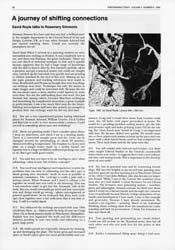
From A Journey of Shifting Connections, "Printmaking Today" 1995
Rosemary Simmons in conversation with David Royle
D.R.
Painting can be immensely rich and "orchestral". Colour, for me, is a vitally
important part. But so are imagery, surface, gesture, scale and visual
rhythm. Paint can do almost anything. When I make prints it is the
technical constraint of etching that appeals to me. It is like taking a limited
thing and making it do more. It is also strongly drawing-based, and
drawing in etching is a brilliantly useful and exciting discipline. Black and
white suits this approach. Colour in etching can very easily appear
coloured-in rather than conceived in colour.
R.S.
Please tell us something about the work in your 1994 exhibition
Oasis…to…Orpheus and the prints sharing the same ideas and
development.
D.R.
During 1991 and 1992 I made the ten large paintings of the Oasis series. In
July 1992 we went right across France to the south and back again. The
visual and atmospheric memories of this trip became very influential. On
our return I made five important etchings. The printer’s proofs of all five
were later bought by the British Museum. Riviera Night came immediately,
other prints, drawings and paintings followed. As with the Déjeuner series,
it was etching that helped the painting move on. The initial imagery for the
Two Pools paintings came from a short visit to Antonia’s French house, the
raised swimming pool and the lower, overgrown and shaded water. The
first emergence of the mottled "creature" came in an aquatint called Two
Pools, which I started as a challenge to myself, intending to get the most
out of one aquatint, one biting process and some direct scraping. This plate
became the seed of a larger body of further work and eventually the major
paintings linked by the "dead Orpheus" imagery.
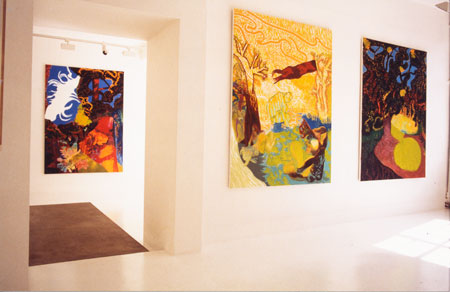
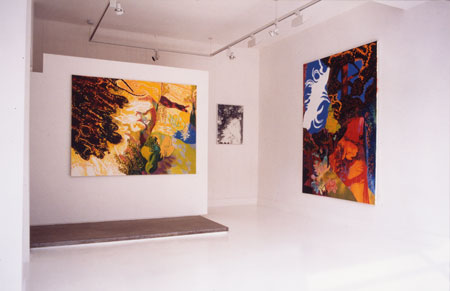
From an Interview on "Kaleidoscope", BBC Radio 4, 6th March 1992
Natalie Wheen talking to A.S. Byatt and David Royle in the Beardsmore Gallery
N.W.
David Royle is a name that has not been heard too much on the art scene even though he has been painting away for some twenty- odd years. But this is David Royle’s year. He was awarded a Wingate Scholarship, which means he can concentrate on his painting, and this week sees the opening of two large exhibitions of his recent work in London, each of them featuring a large series of paintings with their associated drawings and sketches. It is a remarkable record of single-minded determination and a sense of purpose that was there right from the early days. The novelist A.S. Byatt taught David when he was a student at the Central School in London.
A.S.B.
He has got this central sense of the importance of art which I think is what has kept him going. It is not worldly ambition, although he has that, but it’s this sense that this really matters, which he doesn’t question, which I envy him in a way. You always wonder whether you might simply be mad if you sit alone in a room day after day trying to make a work of art. I don’t think David does wonder if he is mad. He just knows, that having found this, it is the most important thing to do. The thing about David’s work is that the more you look the more you see in it and the more complicated the relationships between the parts are. So you find that what you thought was a brilliant piece of light and shadow in the corner of a painting is in fact also a face with huge goggle-like glasses on it, a kind of David caricature of David, which is also part of the rhythm of the colour across the surface. You find these things, also, if you see the whole series of paintings together, which is wonderful. You find little motifs repeated again and again so that the woman, who appears to be rather sadly and thoughtfully bending her breasts over the water in a green outline inside a cavern in one picture, is looking quite cheerful and bouncy in another one. It is like seeing the endless movement of natural things in brilliant colours which bring a kind of sunlight of their own into the exhibition.
N.W.
Antonia Byatt talking to us at the Private View at the brand new Beardsmore Gallery which is now showing the Déjeuner series. This is eight large oils and associated works exploring the ideas of Manet’s painting "Le Déjeuner sur l’herbe". In the foreground, of the Manet painting that is, there are a couple of young blades-about-town, fully dressed, and they are smacking their lips over a rather voluptuous naked girl with whom, or perhaps on whom, they have just been picnicking. In the middle-distance, in a pool in the woods, there is another woman, half-dressed who is bathing herself. Well, David Royle took a colour copy of it, stuck it on his studio wall, and it began to work on his imagination.
D.R.
It’s partly to do with testing yourself against the European tradition because the Manet in its turn links back to Titian and links back to all sorts of fête champêtre type imagery. Also there was something about just putting those figures in that landscape, especially that female figure in the pool, who became a kind of Cyclops, some sort of spirit of the place. Before I knew it, basically, I had to make more paintings to solve a practical problem, then I had the beginnings of what was obviously another series and it ran to eight canvasses with associated drawings and etchings.
N.W.
It’s interesting that number eight is exactly the same size as number one and a number of the colours are there that were in the first one, but everything seems to have got a depth of colour to it: the pool in the middle is very vibrant red with oranges and golds and purples in it. Are you coming to a conclusion of colour-as-form rather than the shapes and the vegetation and the foliage?
D.R.
I wouldn’t say colour-as-form, I’d say colour-as-light perhaps, because I’m very interested in the way colour can generate what appears to be light. If you look at this one (no.8) there are almost three sets of light relating: one is the enclosed, almost womb-like red-gold of the woman in the pool, an enclosed sort of cave, then you have what seems like a softer natural reflecting light to do with the other reclining figure, with the debris of the picnic or the bits of plant, and that’s almost like the light through foliage reflecting back off grass, it’s softer, it’s more lemon and cream. And then you have the blaze of the sky with this giant furry cloud whizzing across. It’s also about shifts of scale, it’s about the way we perceive space, the way that it is not necessarily a fixed set of values, that there is a certain amount of flexibility and that it can be re-jigged. Some people have called it some sort of patch-working. I hope it is a patch-working without seams.
N.W.
Well. I didn’t see any seams and, seeing the pictures while the gallery was emptyish of people. I thought there was a tremendous energy between the paintings which seemed to keep my eye anyway constantly engaged in the changing effects of these different lights and different consistencies.
Natalie Wheen talking to A.S. Byatt and David Royle in the Beardsmore Gallery
N.W.
David Royle is a name that has not been heard too much on the art scene even though he has been painting away for some twenty- odd years. But this is David Royle’s year. He was awarded a Wingate Scholarship, which means he can concentrate on his painting, and this week sees the opening of two large exhibitions of his recent work in London, each of them featuring a large series of paintings with their associated drawings and sketches. It is a remarkable record of single-minded determination and a sense of purpose that was there right from the early days. The novelist A.S. Byatt taught David when he was a student at the Central School in London.
A.S.B.
He has got this central sense of the importance of art which I think is what has kept him going. It is not worldly ambition, although he has that, but it’s this sense that this really matters, which he doesn’t question, which I envy him in a way. You always wonder whether you might simply be mad if you sit alone in a room day after day trying to make a work of art. I don’t think David does wonder if he is mad. He just knows, that having found this, it is the most important thing to do. The thing about David’s work is that the more you look the more you see in it and the more complicated the relationships between the parts are. So you find that what you thought was a brilliant piece of light and shadow in the corner of a painting is in fact also a face with huge goggle-like glasses on it, a kind of David caricature of David, which is also part of the rhythm of the colour across the surface. You find these things, also, if you see the whole series of paintings together, which is wonderful. You find little motifs repeated again and again so that the woman, who appears to be rather sadly and thoughtfully bending her breasts over the water in a green outline inside a cavern in one picture, is looking quite cheerful and bouncy in another one. It is like seeing the endless movement of natural things in brilliant colours which bring a kind of sunlight of their own into the exhibition.
N.W.
Antonia Byatt talking to us at the Private View at the brand new Beardsmore Gallery which is now showing the Déjeuner series. This is eight large oils and associated works exploring the ideas of Manet’s painting "Le Déjeuner sur l’herbe". In the foreground, of the Manet painting that is, there are a couple of young blades-about-town, fully dressed, and they are smacking their lips over a rather voluptuous naked girl with whom, or perhaps on whom, they have just been picnicking. In the middle-distance, in a pool in the woods, there is another woman, half-dressed who is bathing herself. Well, David Royle took a colour copy of it, stuck it on his studio wall, and it began to work on his imagination.
D.R.
It’s partly to do with testing yourself against the European tradition because the Manet in its turn links back to Titian and links back to all sorts of fête champêtre type imagery. Also there was something about just putting those figures in that landscape, especially that female figure in the pool, who became a kind of Cyclops, some sort of spirit of the place. Before I knew it, basically, I had to make more paintings to solve a practical problem, then I had the beginnings of what was obviously another series and it ran to eight canvasses with associated drawings and etchings.
N.W.
It’s interesting that number eight is exactly the same size as number one and a number of the colours are there that were in the first one, but everything seems to have got a depth of colour to it: the pool in the middle is very vibrant red with oranges and golds and purples in it. Are you coming to a conclusion of colour-as-form rather than the shapes and the vegetation and the foliage?
D.R.
I wouldn’t say colour-as-form, I’d say colour-as-light perhaps, because I’m very interested in the way colour can generate what appears to be light. If you look at this one (no.8) there are almost three sets of light relating: one is the enclosed, almost womb-like red-gold of the woman in the pool, an enclosed sort of cave, then you have what seems like a softer natural reflecting light to do with the other reclining figure, with the debris of the picnic or the bits of plant, and that’s almost like the light through foliage reflecting back off grass, it’s softer, it’s more lemon and cream. And then you have the blaze of the sky with this giant furry cloud whizzing across. It’s also about shifts of scale, it’s about the way we perceive space, the way that it is not necessarily a fixed set of values, that there is a certain amount of flexibility and that it can be re-jigged. Some people have called it some sort of patch-working. I hope it is a patch-working without seams.
N.W.
Well. I didn’t see any seams and, seeing the pictures while the gallery was emptyish of people. I thought there was a tremendous energy between the paintings which seemed to keep my eye anyway constantly engaged in the changing effects of these different lights and different consistencies.

